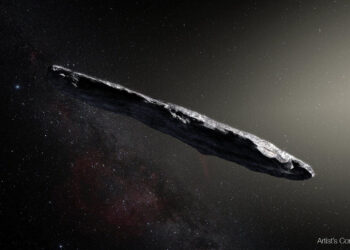
In June 2021, astronomers were stoked to announce the discovery of the Bernardinelli-Bernstein comet (C/2014 UN271), by far the largest comet ever measured. With a diameter of nearly 100 km (62 miles), Bernardinelli-Bernstein is about 1,000 larger than a typical comet in our solar system.
Scientists initially found the gargantuan comet zipping through the Oort cloud — a shell of predominantly icy debris in the outermost reaches of the solar system. They could even discern a glowing tail and coma, a sign that the comet may be approaching the warmer inner solar system. A new study due to be published in the Astrophysical Journal Letters has confirmed just that: the Bernardinelli-Bernstein comet will reach its perihelion, the point at which it is closest to the sun, sometime in 2031.
There’s no need to panic, though. Even at its closest position to the sun, the comet will still be very far away. Astronomers expect the comet to come within 11 astronomical units (AU) of the sun, where 1 AU is the distance between the Sun and Earth. That would place Bernardinelli-Bernstein safely away, just beyond Saturn’s orbit.
So, a decade from now, scientists will have the unique opportunity to study and image a comet in a weight class of its own from a safe distance. By then, the Vera C. Rubin Observatory, currently under construction on the El Penón peak of Cerro Pachón in northern Chile, should finally come online. The ground-based telescope will be equipped with state-of-the-art instruments, allowing it to study the nature of dark matter and perform sky surveys, as well as track comets.
The 2031 flyby will be a once in a 3.5 million year opportunity — the last time the comet came this close to the sun. The last time the Bernardinelli-Bernstein comet showed its glowy tail in the solar system, our genus (Homo) didn’t even exist. Its current inward journey began at a distance of over 40,000 AU, which is about one 7th of the distance to the nearest star. For comparison, Pluto is 39 AU from the Sun, on average.

The comet was discovered by Pedro Bernardinelli and Gary Bernstein, both astronomers at the University of Pennsylvania, while the two were combing through data collected by the 570-megapixel Dark Energy Camera (DECam) mounted on the Víctor M. Blanco 4-meter Telescope at Cerro Tololo Inter-American Observatory (CTIO) in Chile.
“We have the privilege of having discovered perhaps the largest comet ever seen — or at least larger than any well-studied one — and caught it early enough for people to watch it evolve as it approaches and warms up,” said Gary Bernstein in a statement. “It has not visited the Solar System in more than 3 million years.”
While Bernardinelli-Bernstein makes its long journey towards the inner solar system, astronomers won’t exactly stay idle. They will use every tool at their disposal to study the composition and origin of this massive relic. In the process, they may learn a thing or two about the composition of the early solar system and its formation as Oort cloud objects are believed to have remained relatively unchanged since the sun first formed billions of years ago.
“This is a much needed anchor on the unknown population of large objects in the Oort Cloud and their connection with early migration of the ice/gas giants soon after the Solar System was formed,” said Tod Lauer, an astronomer affiliated with the National Science Foundation’s NOIRLab.
“These observations demonstrate the value of long-duration survey observations on national facilities like the Blanco telescope,” says Chris Davis, National Science Foundation Program Director for NOIRLab. “Finding huge objects like Comet Bernardinelli-Bernstein is crucial to our understanding of the early history of our Solar System.”






